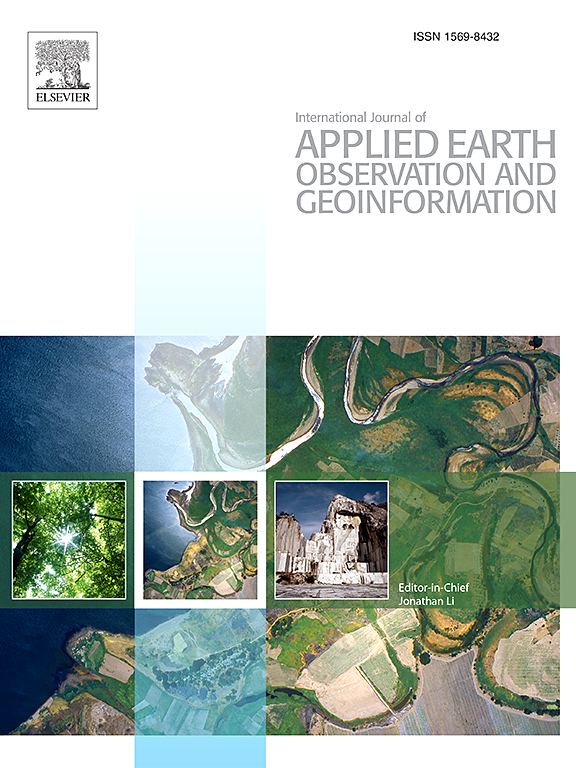我们如何改进数据集成以提高城市气温估算?
IF 7.6
Q1 REMOTE SENSING
International journal of applied earth observation and geoinformation : ITC journal
Pub Date : 2025-05-17
DOI:10.1016/j.jag.2025.104599
引用次数: 0
摘要
高分辨率的城市气温对于分析热浪期间的超额死亡率是必不可少的。多源数据集成作为获取高分辨率数据的重要手段,在城市温度估算中得到了广泛的应用。然而,目前的研究主要集中在整合官方气象站观测、卫星产品和再分析数据集上。尽管降雨对气温有显著的降温作用,但尚无研究探讨降雨相关变量对高分辨率气温估算的贡献。此外,由于官方气象站的稀缺,量化气象站密度的影响仍然是一个未充分探索的研究方向。为了应对这些挑战,我们创新地将卫星产品、再分析数据集和天气雷达数据与众包气象站的气温观测相结合。利用遗传编程,我们开发了统计降尺度模型来估计2019年和2022年夏季伦敦的高时空分辨率(每小时1公里)气温。模型的rmse分别为1.694°C(2019)和1.785°C (2022), r平方值分别为0.867和0.862,MAEs分别为1.276°C和1.278°C。值得注意的是,模型的精度随着气象站密度的增加而提高,特别是当气象站密度低于每100平方公里0.5个站点时。此外,高分辨率降雨观测显著影响了气温估计的准确性,仅次于海拔,突出了整合雷达数据的潜力。这些发现可以为旨在改善数据集成以增强城市气温估算的学者提供有价值的见解。本文章由计算机程序翻译,如有差异,请以英文原文为准。
How can we improve data integration to enhance urban air temperature estimations?
High-resolution urban air temperatures are indispensable for analysing excess mortality during heatwaves. As a crucial method for obtaining high-resolution data, multi-source data integration has been widely used in urban temperature estimations. However, current research predominantly focuses solely on integrating official weather station observations, satellite products, and reanalysis datasets. Despite the significant cooling effect of rainfall on air temperatures, no studies have explored the contribution of rainfall-related variables to high-resolution air temperature estimations. Additionally, due to the scarcity of official weather stations, quantifying the impact of station density remains an underexplored research direction. To tackle these challenges, we innovatively integrated satellite products, reanalysis datasets, and weather radar data with air temperature observations from crowdsourced weather stations. Using genetic programming, we developed statistical downscaling models to estimate high spatiotemporal resolution (1-km, hourly) air temperatures in London during the summers of 2019 and 2022. The models achieved RMSEs of 1.694 °C (2019) and 1.785 °C (2022), R-squared values of 0.867 and 0.862, and MAEs of 1.276 °C and 1.278 °C, respectively. Notably, the accuracy of the models was found to improve with increased weather station density, particularly when the density was below 0.5 stations per 100 km2. Moreover, high-resolution rainfall observations significantly impacted the accuracy of air temperature estimations, second only to elevation, highlighting the potential of integrating radar data. These findings can provide valuable insights for scholars aiming to improve data integration for enhancing urban air temperature estimations.
求助全文
通过发布文献求助,成功后即可免费获取论文全文。
去求助
来源期刊

International journal of applied earth observation and geoinformation : ITC journal
Global and Planetary Change, Management, Monitoring, Policy and Law, Earth-Surface Processes, Computers in Earth Sciences
CiteScore
12.00
自引率
0.00%
发文量
0
审稿时长
77 days
期刊介绍:
The International Journal of Applied Earth Observation and Geoinformation publishes original papers that utilize earth observation data for natural resource and environmental inventory and management. These data primarily originate from remote sensing platforms, including satellites and aircraft, supplemented by surface and subsurface measurements. Addressing natural resources such as forests, agricultural land, soils, and water, as well as environmental concerns like biodiversity, land degradation, and hazards, the journal explores conceptual and data-driven approaches. It covers geoinformation themes like capturing, databasing, visualization, interpretation, data quality, and spatial uncertainty.
 求助内容:
求助内容: 应助结果提醒方式:
应助结果提醒方式:


